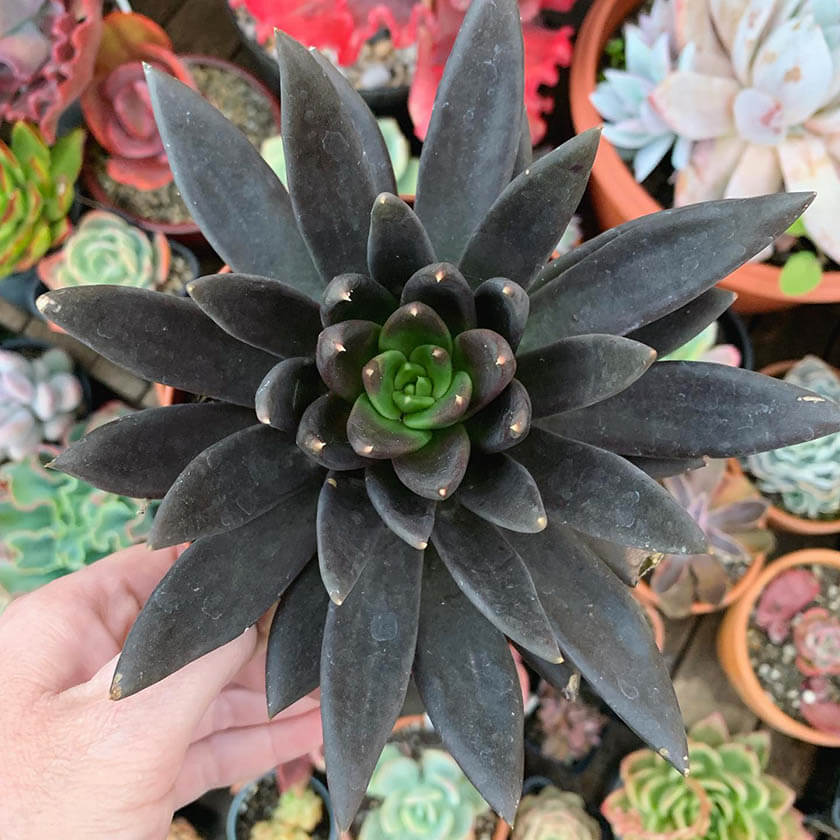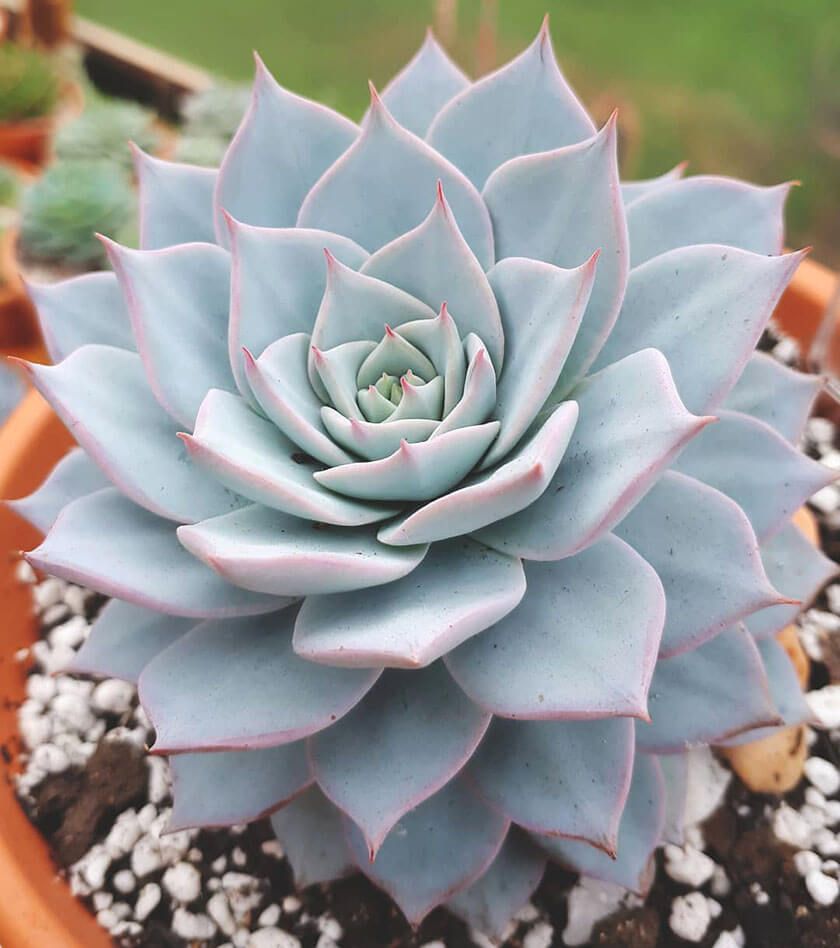
Echeveria Types and Care (Comparison Table)

There are many Echeveria types, among the most popular are agavoides, black night, black prince, chihuahuensis, elegans, laui, lola, peacockii, secunda, setosa, and more.
In this article, I will analyze each of them, their characteristics, and care requirements. Finally, I will provide you with a comparative table to make it easier for you to differentiate them and choose the best one for you.
Echeveria Agavoides
Echeveria Agavoides is a small succulent without a stem, with a rosette of leaves that can reach a diameter of 7-15 centimeters.
Most of them grow individually, but some mature plants in good conditions can produce offsets.
Its leaves are green, triangular, about 6 mm thick, and more pointed than other echeverias. Hence its name agavoides, "resembling an agave."
- Family: Crassulaceae
- Place of origin: Mexico (Guanajuato, Hidalgo, and SLP)
- Height: 3-5 inches (8-12 cm)
- Light: Well-lit location, can be in the early morning and late afternoon, but avoid intense midday sun.

Echeveria Black Knight
The initial name of this succulent was Echeveria Affinis, but when it was taken from Mexico to Asia, it started being called Echeveria Black Knight, and that's why it is known by both names.
Its leaves are black as long as they are kept outdoors, as this succulent cannot thrive indoors. Under indoor conditions, the plant will usually start to etiolate and lose its black color, turning greener.
- Family: Crassulaceae
- Place of origin: Mexico (Durango, Sinaloa, and Chihuahua)
- Height: up to 6 inches (15 cm)
- Light: Well-lit location, prefers direct sun but in very hot climates, some shade in the afternoon is recommended.

Echeveria Black Prince
Echeveria Black Prince is a hybrid created through the pollination of Echeveria Black Knight and Echeveria Shaviana.
This echeveria stands out for its rosette of green-purple leaves that can measure 10-25 cm in diameter.
Like many purple succulents, it achieves better coloration when placed in brightly lit spaces. During summer, it produces reddish flowers.
- Family: Crassulaceae
- Place of origin: Hybrid, not applicable
- Height: 4-10 inches (10-25 cm)
- Light: Well-lit location, preferably with filtered sunlight, avoiding direct intense midday sun.

Echeveria Chihuahuensis
A beautiful echeveria that forms a rosette about 10 cm in diameter, with bluish-gray leaves that end in a pronounced pink tip.
The flower stalks can reach up to 25 cm above the rosette, displaying coral pink flowers with a yellow interior.
- Family: Crassulaceae
- Place of origin: Mexico (Northern region)
- Height: 4-10 inches (10-25 cm)
- Light: Preferably direct sun but also suitable for indoors (semi-shade) with abundant light.

Echeveria Elegans
Echeveria Elegans, also known as "Mexican snowball," is another beautiful rosette-shaped succulent with bluish-green leaves.
It grows to about 8 inches tall and 12 inches wide. During summer, with good exposure to light, it tends to produce yellow and pink flowers.
- Family: Crassulaceae
- Place of origin: Mexico (Hidalgo)
- Height: up to 8 inches (20 cm)
- Light: Well-lit location, preferably with filtered sunlight, avoiding direct intense midday sun.

Echeveria Laui
It is one of the most attractive echeverias and highly sought after by succulent collectors. It forms a rosette with light green and reddish-toned leaves.
Its shape is quite symmetrical, with rounded and plump leaf tips. The flowers are pink, and the stem that supports them can grow from 6 to 20 cm long.
- Family: Crassulaceae
- Place of origin: Mexico (Oaxaca)
- Height: up to 6 inches (15 cm)
- Light: Well-lit location, but avoiding direct sunlight.

Echeveria Lilacina
Also known as Ghost Echeveria due to its pale silver-gray foliage, this succulent is perfect for contrasting with other varieties like Black Prince or Black Knight.
In summer, it produces coral pink flowers and can grow up to 12 inches tall and wide.
It stands out as one of the largest echeverias, but with slow growth. It is also one of the easiest to care for and propagate.
- Family: Crassulaceae
- Place of origin: Mexico (Nuevo Leon)
- Height: up to 12 inches (30 cm)
- Light: It can grow in low-light environments but achieves its maximum beauty in well-lit conditions.

Echeveria Lola
Echeveria Lola is a hybrid created through the pollination of Echeveria Tippy and Echeveria Lilacina. It was created by Dick Wright, a well-known hybridizer from California.
This beautiful succulent has a rosette with pale grayish-green leaves and subtle purple tones when exposed to bright light. In summer, it produces orange-pink flowers.
It can grow up to 6 inches tall (15 cm), with some rosettes reaching 4 inches (10 cm) wide.
- Family: Crassulaceae
- Place of origin: Hybrid
- Height: up to 6 inches (15 cm)
- Light: Prefers well-lit locations where it can receive direct sun either in the morning or afternoon. In some places, it can be cultivated in full sun.

Echeveria Peacockii
Also known as Echeveria Desmetiana, this succulent is formed by large rosettes of bluish-gray or silvery leaves with pointed tips.
During summer, it produces red or orange flowers and can grow up to 12 inches tall with leaves measuring 2 to 3 inches.
- Family: Crassulaceae
- Place of origin: Mexico and California
- Height: up to 12 inches (30 cm)
- Light: Well-lit location but avoiding direct sunlight.

Echeveria Pulvinata
Echeveria Pulvinata, also known as Plush Plant or Chenille Plant, has grayish-green leaves covered in tiny hairs, giving them a velvety appearance.
It can grow up to 12 inches tall and 4 inches wide. Its flowers are small with reddish or orangish tones.
It also stands out as one of the largest echeverias, but with slow growth. Additionally, it is one of the easiest to care for and propagate.
- Family: Crassulaceae
- Place of origin: Mexico (Oaxaca)
- Height: up to 12 inches (30 cm)
- Light: Preferably direct sun but also suitable for indoors (semi-shade) with abundant light.

Echeveria Secunda
Echeveria Secunda, also known as Blue Echeveria, forms a rosette of leaves with blue and green tones.
In late spring and during summer, it usually produces reddish or orangish flowers with yellow tips. It is relatively easy to cultivate and reaches about 6 inches (15 cm) tall and 8-10 inches (20-25 cm) wide.
- Family: Crassulaceae
- Place of origin: Mexico (Guanajuato, Hidalgo, Puebla, and Querétaro)
- Height: up to 6 inches (15 cm)
- Lighting: Preferably direct sun but avoiding intense midday sun.

Echeveria Setosa
Also known by its scientific name Echeveria Pilosa or its English nickname "Mexican firecracker. This beautiful succulent forms a rosette of green leaves covered with small whitish hairs that serve as protection.
It can grow up to 6 inches (15 cm) tall and 10 inches (25 cm) wide. Like many other echeverias, it produces reddish and yellowish petals during summer.
- Family: Crassulaceae
- Place of origin: Mexico (Puebla)
- Height: up to 6 inches (15 cm)
- Light: Well-lit location, preferably with filtered sunlight, avoiding direct exposure.

Comparison Table
| Echeveria Type | Family | Origin | Approx. Height | Light |
|---|---|---|---|---|
| Echeveria Agavoides | Crassulaceae | Mexico (Guanajuato, Hildalgo, and SLP) | 3-5 inches (8-12 cm) | Direct sun, avoiding intense midday sun |
| Echeveria Black Knight | Crassulaceae | Mexico (Durango, Sinaloa, and Chihuahua) | Up to 6 inches (15 cm) | Direct sun with shade in the afternoons |
| Echeveria Black Prince | Crassulaceae | Hybrid | 4-10 inches (10-25 cm) | Preferably filtered light (not direct) |
| Echeveria Chihuahuensis | Crassulaceae | Mexico (northern region) | Up to 10 inches (25 cm) | Direct sun or indoors with abundant light |
| Echeveria Elegans | Crassulaceae | Mexico (Hidalgo) | Up to 8 inches (20 cm) | Preferably filtered light (not direct) |
| Echeveria Laui | Crassulaceae | Mexico (Oaxaca) | Up to 6 inches (15cm) | Abundant light, but avoid direct sun |
| Echeveria Lilacina | Crassulaceae | Mexico (Nuevo Leon) | Up to 12 inches (30cm) | olerates both low and high-light environments |
| Echeveria Lola | Crassulaceae | Hybrid | Up to 6 inches (15 cm) | Direct sun in the mornings or afternoons |
| Echeveria Peacockii | Crassulaceae | Mexico and California | Up to 12 inches (30cm) | Good lighting, but avoid direct sun |
| Echeveria Pulvinata | Crassulaceae | Mexico (Oaxaca) | Up to 12 inches (30cm) | Direct sun or indoors with abundant light |
| Echeveria Secunda | Crassulaceae | Mexico (Guanajuato, Hidalgo, Puebla, and Queretaro) | Up to 6 inches (15 cm) | Direct sun, avoiding intense midday sun |
| Echeveria Setosa | Crassulaceae | Mexico (Puebla) | Up to 6 inches (15 cm) | Preferably filtered light (not direct) |
What do you think of the echeverias?
As you saw, there are many types of echeverias, with various colors, shapes, and sizes. Some require more care than others, but they are all beautiful. Which one did you like the most?
If you liked this article, please consider sharing it with other succulent enthusiasts on your social networks. We will be thrilled if it reaches a wider audience and helps more people learn about the echeverias types, one of the most popular genera in the world of succulents.
All the best taking care of your plants!
Resources and cover image:
Leave a Reply






También te puede interesar